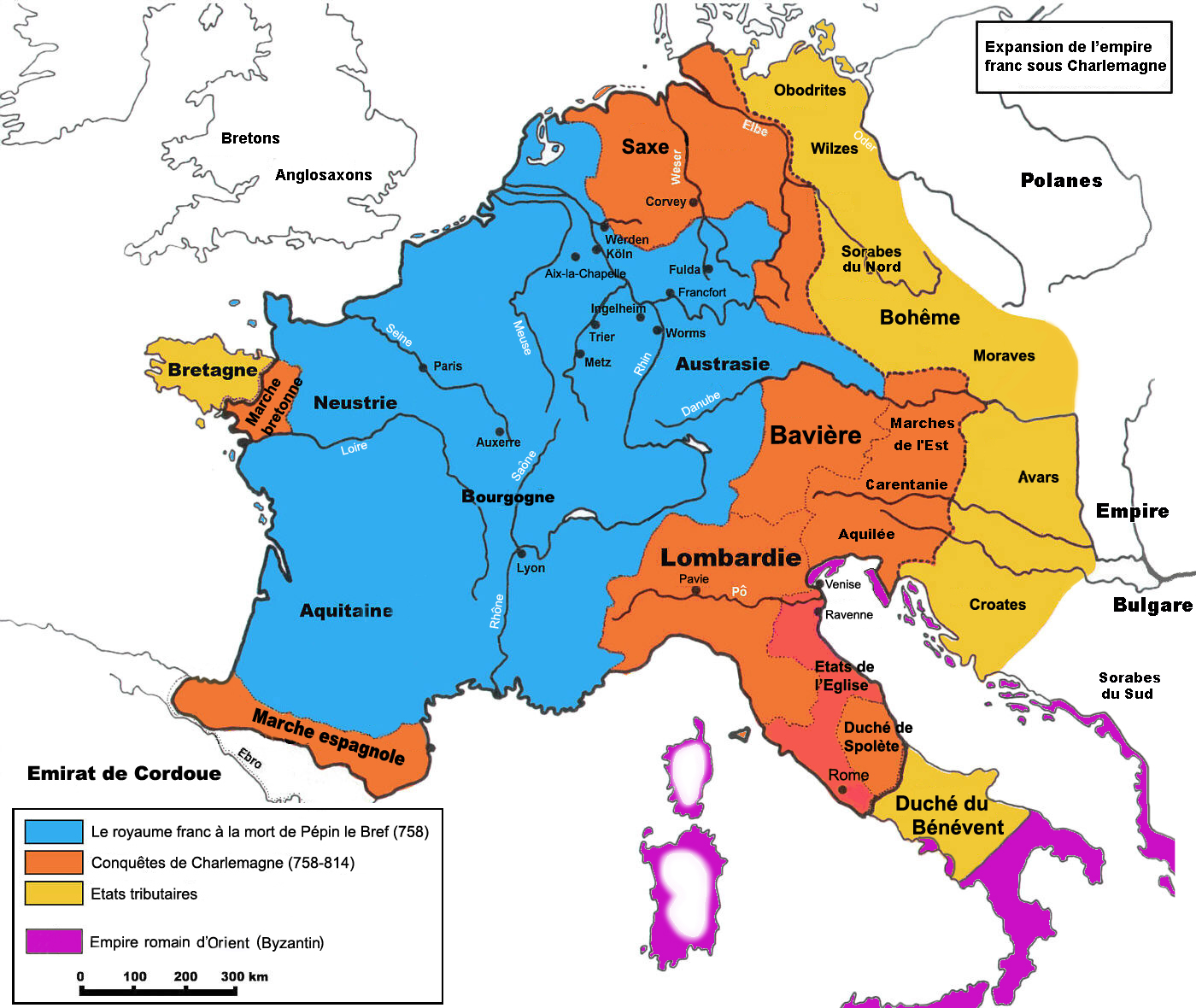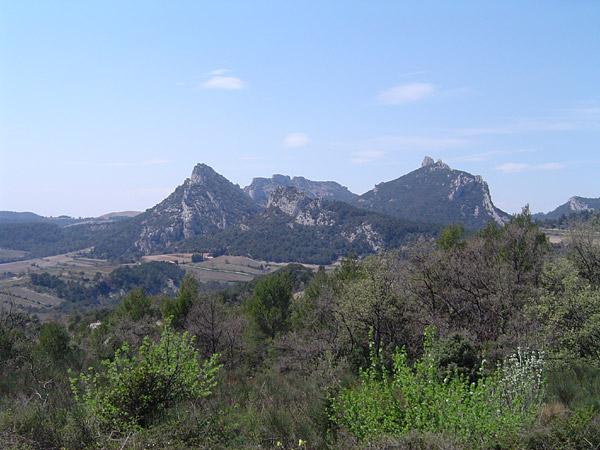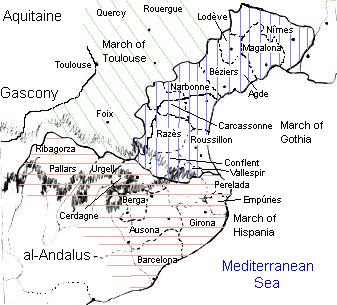|
Muslim Presence In Medieval France
The Muslim presence in medieval France corresponds to the Saracen presence for several periods between 719 and 973 in the province of Septimania and then in Provence until 1197, of Muslim populations, mainly Arabs, Berbers, and also Europeans who converted to Islam ( Muwallads). A first phase of presence, following the Umayyad conquest of Hispania, is recorded between 719 and 759 in the province of Septimania with Narbonne as its capital. A second phase of presence lasted nearly 80 years, between 890 and 973, during which Muslims had established several fortified camps in the vicinity of Saint-Tropez in the middle of the Massif des Maures, with Fraxinetum as its chief town, which Arab written sources call ''Gabal al qilâl'' ("the mountain of the summits"), and ''farahsinêt'' (the phonetic transcription of Fraxinetum), i.e., the present-day hinterland of the Gulf of Saint-Tropez. The Umayyad period (719 - 759) Razzias (759 - 890) After the submission of Roussillon to the Fr ... [...More Info...] [...Related Items...] OR: [Wikipedia] [Google] [Baidu] |
Saracen
upright 1.5, Late 15th-century German woodcut depicting Saracens ''Saracen'' ( ) was a term used both in Greek and Latin writings between the 5th and 15th centuries to refer to the people who lived in and near what was designated by the Romans as Arabia Petraea and Arabia Deserta. The term's meaning evolved during its history of usage. During the Early Middle Ages, the term came to be associated with the tribes of Arabia. The oldest known source mentioning "Saracens" in relation to Islam dates back to the 7th century, in the Greek-language Christian tract '' Doctrina Jacobi''. Among other major events, the tract discusses the Muslim conquest of the Levant, which occurred after the rise of the Rashidun Caliphate following the death of the Islamic prophet Muhammad. The Roman Catholic Church and European Christian leaders used the term during the Middle Ages to refer to Muslims. By the 12th century, "Saracen" developed various overlapping definitions, generally conflatin ... [...More Info...] [...Related Items...] OR: [Wikipedia] [Google] [Baidu] |
Catalonia
Catalonia is an autonomous community of Spain, designated as a ''nationalities and regions of Spain, nationality'' by its Statute of Autonomy of Catalonia of 2006, Statute of Autonomy. Most of its territory (except the Val d'Aran) is situated on the northeast of the Iberian Peninsula, to the south of the Pyrenees mountain range. Catalonia is administratively divided into four Provinces of Spain, provinces or eight Vegueries of Catalonia, ''vegueries'' (regions), which are in turn divided into 43 Comarques of Catalonia, ''comarques''. The capital and largest city, Barcelona, is the second-most populous Municipalities in Spain, municipality in Spain and the fifth-most populous List of metropolitan areas in Europe, urban area in the European Union. > > > ''Catalonia'' theoretically derived. During the Middle Ages, Byzantine Empire, Byzantine chroniclers claimed that ''Catalania'' derives from the local medley of Goths with Alans, initially constituting a ''Goth-Alania''. Othe ... [...More Info...] [...Related Items...] OR: [Wikipedia] [Google] [Baidu] |
Corsica
Corsica ( , , ; ; ) is an island in the Mediterranean Sea and one of the Regions of France, 18 regions of France. It is the List of islands in the Mediterranean#By area, fourth-largest island in the Mediterranean and lies southeast of the Metropolitan France#Hexagon, French mainland, west of the Italian Peninsula and immediately north of the Italian island of Sardinia, the nearest land mass. A single chain of mountains makes up two-thirds of the island. , it had a population of 355,528. The island is a Single territorial collectivity, territorial collectivity of France, and is expected to achieve "a form of autonomy" in the near future. The regional capital is Ajaccio. Although the region is divided into two administrative Departments of France, departments, Haute-Corse and Corse-du-Sud, their respective regional and departmental Territorial collectivity, territorial collectivities were merged on 1 January 2018 to form the single territorial collectivity of Corsica. Corsican aut ... [...More Info...] [...Related Items...] OR: [Wikipedia] [Google] [Baidu] |
Sicily
Sicily (Italian language, Italian and ), officially the Sicilian Region (), is an island in the central Mediterranean Sea, south of the Italian Peninsula in continental Europe and is one of the 20 regions of Italy, regions of Italy. With 4.7 million inhabitants, including 1.2 million in and around the capital city of Palermo, it is both the largest and most populous island in the Mediterranean Sea. Sicily is named after the Sicels, who inhabited the eastern part of the island during the Iron Age. Sicily has a rich and unique culture in #Art and architecture, arts, Music of Sicily, music, #Literature, literature, Sicilian cuisine, cuisine, and Sicilian Baroque, architecture. Its most prominent landmark is Mount Etna, the tallest active volcano in Europe, and one of the most active in the world, currently high. The island has a typical Mediterranean climate. It is separated from Calabria by the Strait of Messina. It is one of the five Regions of Italy#Autonomous regions with s ... [...More Info...] [...Related Items...] OR: [Wikipedia] [Google] [Baidu] |
Carolingian Empire
The Carolingian Empire (800–887) was a Franks, Frankish-dominated empire in Western and Central Europe during the Early Middle Ages. It was ruled by the Carolingian dynasty, which had ruled as List of Frankish kings, kings of the Franks since 751 and as kings of the Lombards in Italy from 774. In 800, Pope Leo III crowned the Frankish king Charlemagne as Roman emperor in return for political protection, disregarding the universalist claims of the weakened Byzantine Empire. The Carolingian Empire is sometimes considered the first phase in the history of the Holy Roman Empire. After a Carolingian civil war, civil war from 840 to 843 following the death of Emperor Louis the Pious, the empire was divided into autonomous kingdoms, with one king still recognised as emperor, but with little authority outside his own kingdom. The unity of the empire and the hereditary right of the Carolingians continued to be acknowledged. In 884, Charles the Fat reunited all the Carolingian kingdoms f ... [...More Info...] [...Related Items...] OR: [Wikipedia] [Google] [Baidu] |
Orange, Vaucluse
Orange (; Provençal dialect, Provençal: ''Aurenja'' or ''Aurenjo'' ) is a Communes of France, commune in the Vaucluse Departments of France, department in the Provence-Alpes-Côte d'Azur Regions of France, region in Southeastern France. It is about north of Avignon, on the departmental border with Gard, which follows the Rhône and also constitutes the regional border with Occitania (administrative region), Occitania. Orange is the second-most populated city in Vaucluse, after Avignon. Name The name itself derived from an earlier Proto-Celtic *''far-aws(y)o''-, which literally means 'in front of the ear' (cf. Old Irish ''ara'', ''arae''; Ancient Greek ''pareiaí'', ''parauai'' < *''par-ausiā''). This became the Gaulish ''ar-aus(i)o''- ('temple, cheek'). It is cognate with the name of other ancient settlements, including ''Arausa'', ''Arausia'', ''Arausona'' (Dalmatia) and the nearby ''Oraison'' (Alpes-de-Haute-Provence). The settlement ... [...More Info...] [...Related Items...] OR: [Wikipedia] [Google] [Baidu] |
Carcassonne
Carcassonne is a French defensive wall, fortified city in the Departments of France, department of Aude, Regions of France, region of Occitania (administrative region), Occitania. It is the prefectures in France, prefecture of the department. Inhabited since the Neolithic Period, Carcassonne is located in the plain of the Aude (river), Aude between historic trade routes, linking the Atlantic to the Mediterranean Sea and the Massif Central to the Pyrénées. Its strategic importance was quickly recognised by the Ancient Rome, Romans, who occupied its hilltop until the demise of the Western Roman Empire. In the fifth century, the region of Septimania was taken over by the Visigoths, who founded the city of Carcassonne in the newly established Visigothic Kingdom. Its citadel, known as the Cité de Carcassonne, is a medieval fortress dating back to the Roman Gaul, Gallo-Roman period and restored by the theorist and architect Eugène Viollet-le-Duc between 1853 and 1879. It was adde ... [...More Info...] [...Related Items...] OR: [Wikipedia] [Google] [Baidu] |
William Of Gellone
William of Gellone ( 755 – 28 May 812 or 814), the medieval William of Orange, was the second Duke of Toulouse from 790 until 811. In 804, he founded the abbey of Gellone. He was canonized a saint in 1066 by Pope Alexander II."William of Aquitaine, St." Encyclopedia.com. Retrieved on 2014-01-17. In the tenth or eleventh century, a Latin hagiography, the ''Vita sancti Willelmi'', was composed. By the twelfth century, William's legend had grown. He is the hero of an entire cycle of ''chansons de geste'', the earliest of which is the ''Chanson de Guillaume'' of about 1140. In the ''chansons'', he is nicknamed ''Fierabras (nickname), Fièrebrace'' (fierce or strong arm) due to his apparent strength and the ''marquis au court nez'' (margrave with the short nose) as the result of an injur ... [...More Info...] [...Related Items...] OR: [Wikipedia] [Google] [Baidu] |
Dentelles De Montmirail
The Dentelles de Montmirail are a small Mountain range, chain of mountains in Provence in France, in the ''département in France, département'' of Vaucluse, located just to the south of the village of Vaison-la-Romaine. They are foothills of the highest peak in Provence, Mont Ventoux, which is situated just to the east. The dramatically jagged shape of their peaks was formed by horizontal strata of Jurassic limestone being folded and forced into a nearly upright position and subsequently eroded into sharp-edged ridges and spikes. The highest peak of the Dentelles is St-Amand, at 734 m (2,400 ft). The range, which is about 8 km wide, offers over 600 trails for walking, rock climbing, and mountain biking. The foot of the Dentelles is surrounded by vineyards of the Rhône wine, Rhône Valley. Etymology Their name ''dentelles'', the French word for lace, refers to their shape obtained by erosion, while ''Montmirail'' is derived from the Latin ''mons mirabilis ... [...More Info...] [...Related Items...] OR: [Wikipedia] [Google] [Baidu] |
Reconquista
The ''Reconquista'' (Spanish language, Spanish and Portuguese language, Portuguese for ) or the fall of al-Andalus was a series of military and cultural campaigns that European Christian Reconquista#Northern Christian realms, kingdoms waged against the al-Andalus, Muslim kingdoms following the Muslim conquest of the Iberian Peninsula by the Umayyad Caliphate, culminating in the reign of the Catholic Monarchs of Spain. The beginning of the ''Reconquista'' is traditionally dated to the Battle of Covadonga ( or 722), in which an Kingdom of Asturias, Asturian army achieved the first Christian victory over the forces of the Umayyad Caliphate since the beginning of the military invasion. The ''Reconquista'' ended in 1492 with the Granada War#Last stand at Granada, fall of the Nasrid kingdom of Granada to the Catholic Monarchs of Spain, Catholic Monarchs. In the late 10th century, the Umayyad vizier Almanzor waged a series of military campaigns for 30 years in order to subjugate ... [...More Info...] [...Related Items...] OR: [Wikipedia] [Google] [Baidu] |
Marca Hispanica
The Spanish March or Hispanic March was a march or military buffer zone established c. 795 by Charlemagne in the eastern Pyrenees and nearby areas, to protect the new territories of the Christian Carolingian Empire—the Duchy of Gascony, the Duchy of Aquitaine, and Septimania—from the Muslim Umayyad Emirate of Córdoba in al-Andalus. In its broader meaning, the ''Spanish March'' sometimes refers to a group of early Iberian and trans-Pyrenean lordships or counts coming under Frankish rule. As time passed, these lordships merged or gained independence from Frankish imperial rule. Geographical context The area of the Spanish March broadly corresponds to the eastern regions between the Pyrenees and the Ebro. The local population of the march was diverse. It included Basques in its northwestern valleys, the Jews of Occitania, and a large Occitano-Romance-speaking population governed by the Visigothic Code, all of them under the influence of al-Andalus since their lords had v ... [...More Info...] [...Related Items...] OR: [Wikipedia] [Google] [Baidu] |
Emirate Of Córdoba
An emirate is a territory ruled by an emir, a title used by monarchs or high officeholders in the Muslim world. From a historical point of view, an emirate is a political-religious unit smaller than a caliphate. It can be considered equivalent to a principality in non-Muslim contexts. Currently in the world, there are two emirates that are independent states (Kuwait and Qatar), one state ruled by an unrecognised emirate (Afghanistan), and a state that consists of a federation of seven emirates (the United Arab Emirates). A great number of previously independent emirates around the world are now part of larger states. Etymology Etymologically, emirate or amirate ( ' plural: ' is the quality, dignity, office, or territorial competence of any emir (prince, commander, governor, etc.). In English, the term is pronounced or in British English and or in American English. Types Monarchies The United Arab Emirates is a federal state that comprises seven federal emirates, each ad ... [...More Info...] [...Related Items...] OR: [Wikipedia] [Google] [Baidu] |







